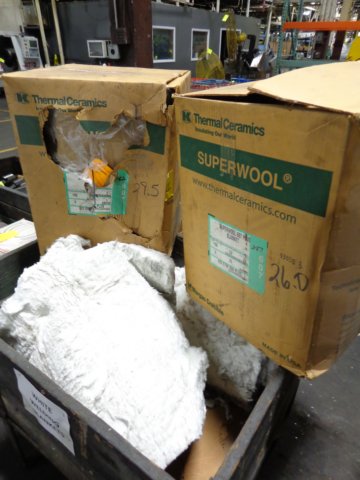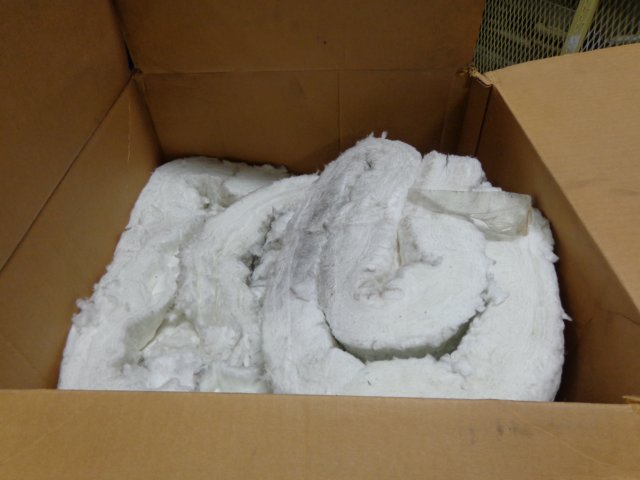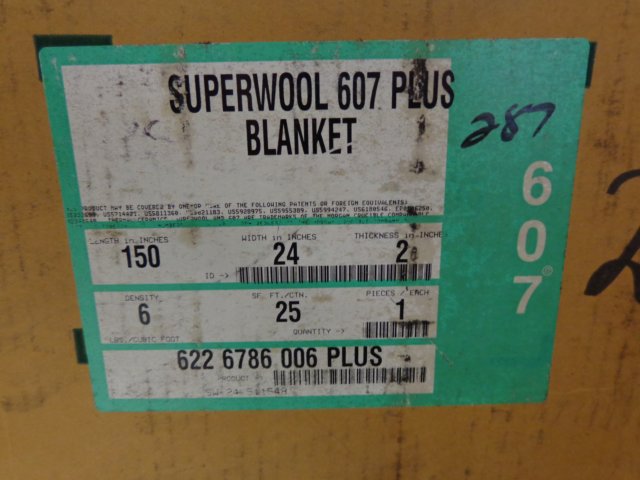Results 11 to 20 of 20
-
04-29-2015, 05:16 PM #11"My words are of iron..."


- Join Date
- Oct 2006
- Posts
- 1,898
Thanked: 995
Randy, just down the street from you (so to speak) is Smith Sharpe Firebrick supply. www.ssfbs.com
If you call and get lucky you will talk with Donna, who has forgotten more about refractories than I think was ever known before. If she says you're good to go, go.
Plan on replacing the lining. Cerowools are lightweight and you will always risk banging a billet around on the inside, or someone like me generates a billet with leftover flux on it. Stuff will just eat the lining eventually.
I'd recommend buying (from Donna) a little bucket of castible refractory (works like concrete). Line your forge with the soft stuff then put a layer of hard castible in the bottom. You won't have to hold your irons all the time cause you can rest them on the bottom without hurting the lining. Anything that drips down there won't eat it up nearly so fast. You worked in my hard cast forge and that thing was probably 20 years old when you played with it. The hard cast stuff is much more durable. But it takes a long time to heat up. The optimum balance for small forges has been a light lining up top and a hard pan below.
She also sells a compound called MACOTE or something like it. It works like ITC100 but lots cheaper and it will stabilize any worries about particles. Be careful when applying any coatings to the lightweight insulators. They work better because they have air spaces between the fibers. If you crush all that down with a heavy coating, or mash it putting the stuff on, you lose some of the potential work from the insulator.
For the price, I think you're living up to your bargain hunting legend, and would not pass on this if you made the offer to me.
Let me know if you need help with any of the other specs.
-
The Following 2 Users Say Thank You to Mike Blue For This Useful Post:
randydance062449 (04-29-2015), Utopian (04-30-2015)
-
04-29-2015, 05:26 PM #12Hones & Honing




- Join Date
- May 2005
- Location
- Saint Paul, Minnesota, United States
- Posts
- 8,023
- Blog Entries
- 1
Thanked: 2209
Woohoo! Got it on an Internet auction site. $14.50 !



Last edited by randydance062449; 04-29-2015 at 05:37 PM.
Randolph Tuttle, a SRP Mentor for residents of Minnesota & western Wisconsin
-
04-29-2015, 05:58 PM #13"My words are of iron..."


- Join Date
- Oct 2006
- Posts
- 1,898
Thanked: 995
Well done!
-
05-01-2015, 03:24 AM #14Senior Member

- Join Date
- Feb 2015
- Location
- Florida
- Posts
- 507
Thanked: 49
Mike, I heard a long time ago that putting a slip coat of the bubble alumina goop over the castable or tile bottom will help greatly with flux damage. Have you ever tried that? In the past, I have just used a second "sacrificial" piece of kiln shelving tile when I forge weld, but that is not so cheap.
-
05-01-2015, 05:20 AM #15"My words are of iron..."


- Join Date
- Oct 2006
- Posts
- 1,898
Thanked: 995
I'm certain that just about every possible material has been attempted. The only stuff I remember using that had some resistance to flux was a green plastic high chromium high alumina ram-able refractory. I'll try to find my file with the name in it. Even that would degrade given enough time and heat. It was tougher than some though.
-
05-01-2015, 06:27 AM #16Senior Member

- Join Date
- Feb 2015
- Location
- Florida
- Posts
- 507
Thanked: 49
Thanks. I have known a couple of folks who put broken up soft firebrick in the bottom of their vertical welding forged and just change it out when it gets nasty. that would be cheaper, but not foolproof, I would think. But then again, what would be foolproof with molten acid lava at 2300F?

-
05-01-2015, 04:28 PM #17"My words are of iron..."


- Join Date
- Oct 2006
- Posts
- 1,898
Thanked: 995
Just for the rest of the readers, there is a long debate about the benefits and detriments of the vertical versus horizontal forge. To simplify the conclusion of that debate, some people drive Fords and some drive Chevy's. They all have four wheels and take you places you'd rather not walk.
I'm fairly certain that Randy is building a horizontal forge. Those are known for having direct flux puddling on the bottom. I use a horizontal forge and simply expect to rebuild the bottom from time to time. It's a part of working maintenance, when required, with that kind of forge. I am happy with my decades old horizontal forges, as are a number of good smiths who use them.
Logically though, I don't see how running a vertical forge would really create a flux problem. All the liquids drop to the bottom where you're not resting any metal. I know some folks out west who are blissfully happy with their decades old vertical forges and who never look in the bottom. The walls are not degrading to any visible degree because flux doesn't get to the walls.
The differences for me are in how the tool works and how you are required to approach that tool with the material to be worked. Each type of forge requires a different approach. Neither is better or worse than the other. As I was taught, and admittedly tend to teach, the horizontal type has several advantages, in my mind, given my experience and given the tooling (think tongs, lots of tongs) in my shop.
This does not prevent me from using a vertical forge with good effect. But my practice modifies when I'm working in that kind of shop.

-
The Following User Says Thank You to Mike Blue For This Useful Post:
randydance062449 (05-04-2015)
-
05-01-2015, 04:43 PM #18"My words are of iron..."


- Join Date
- Oct 2006
- Posts
- 1,898
Thanked: 995
Here are two relatively flux resistant refractories.
Known in Europe as Greenpak 90P (Plus) http://www.anhlimited.co.uk/www.anhl...=1761584&ack=9
and in the US as Ruby AMC from Harbison-Walker Refractories. This is the stuff I have experience using. It's rated to tolerate molten iron in an induction smelter or foundry. Given time, it will degrade in contact with flux but it's still pretty tough stuff.
-
The Following 4 Users Say Thank You to Mike Blue For This Useful Post:
JDM61 (05-01-2015), randydance062449 (05-04-2015), ScottGoodman (05-04-2015), Substance (05-01-2015)
-
05-03-2015, 12:49 AM #19Senior Member




- Join Date
- Nov 2012
- Location
- Across the street from Mickey Mouse in Calif.
- Posts
- 5,320
Thanked: 1184
I lined the bottom of mine with Bubble alumina. It's a fire brick wall and floor and just did it to save the brick floor. It will not stick to anything vertical very easy from what I remember. And the bubbles (yes there are really bubbles in it) are up a 1/4' in dia., so forget having a flat floor unless you apply it really thick. Sorry to say I haven't used it enough to report anything let alone what flux does to it. I am hoping to this summer but all my forging activity is at a stand still right now :<0(
Good judgment comes from experience, and experience....well that comes from poor judgment.
-
05-04-2015, 01:14 AM #20Hones & Honing




- Join Date
- May 2005
- Location
- Saint Paul, Minnesota, United States
- Posts
- 8,023
- Blog Entries
- 1
Thanked: 2209
Mike Blue, thanks for the link to Smith-Sharp.
 I had driven by their old location and saw that it was closed up & for sale so I assumed that they were out of business. Good to know that I can still purchase from them.
I had driven by their old location and saw that it was closed up & for sale so I assumed that they were out of business. Good to know that I can still purchase from them.
Satanite was the stuff I used on my previous propane fired forges and I put a fire brink in for the floor. On the next one I will put in two thin fire bricks with the thought that the top one will be sacrifical.
I will ask Smith-Sharp if they have or can get the Ruby AMC and see what they say.
The forges I currently have were made with straight razors in mind so they are not very long and cannot accommodate a muffle.Randolph Tuttle, a SRP Mentor for residents of Minnesota & western Wisconsin


 15Likes
15Likes LinkBack URL
LinkBack URL About LinkBacks
About LinkBacks






 Reply With Quote
Reply With Quote
